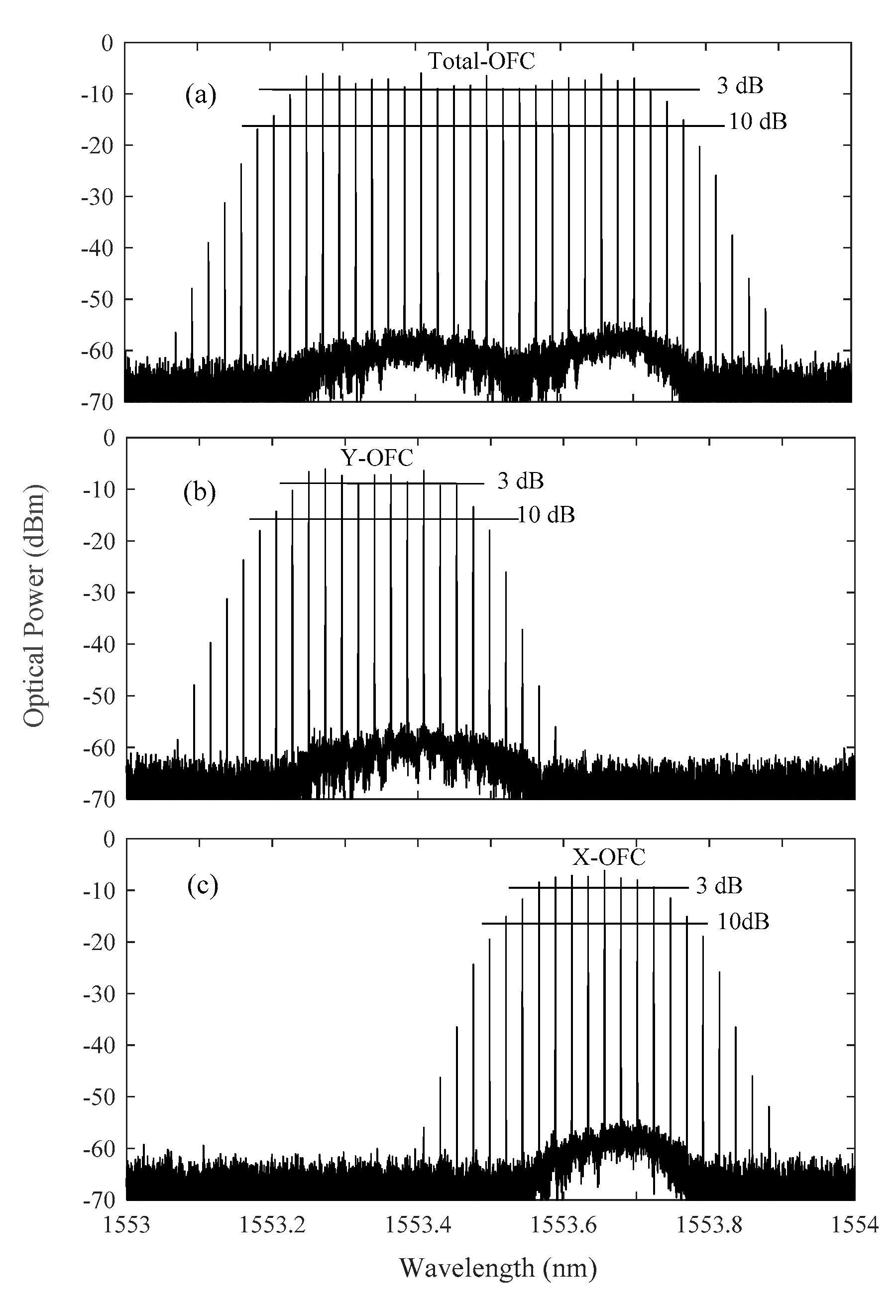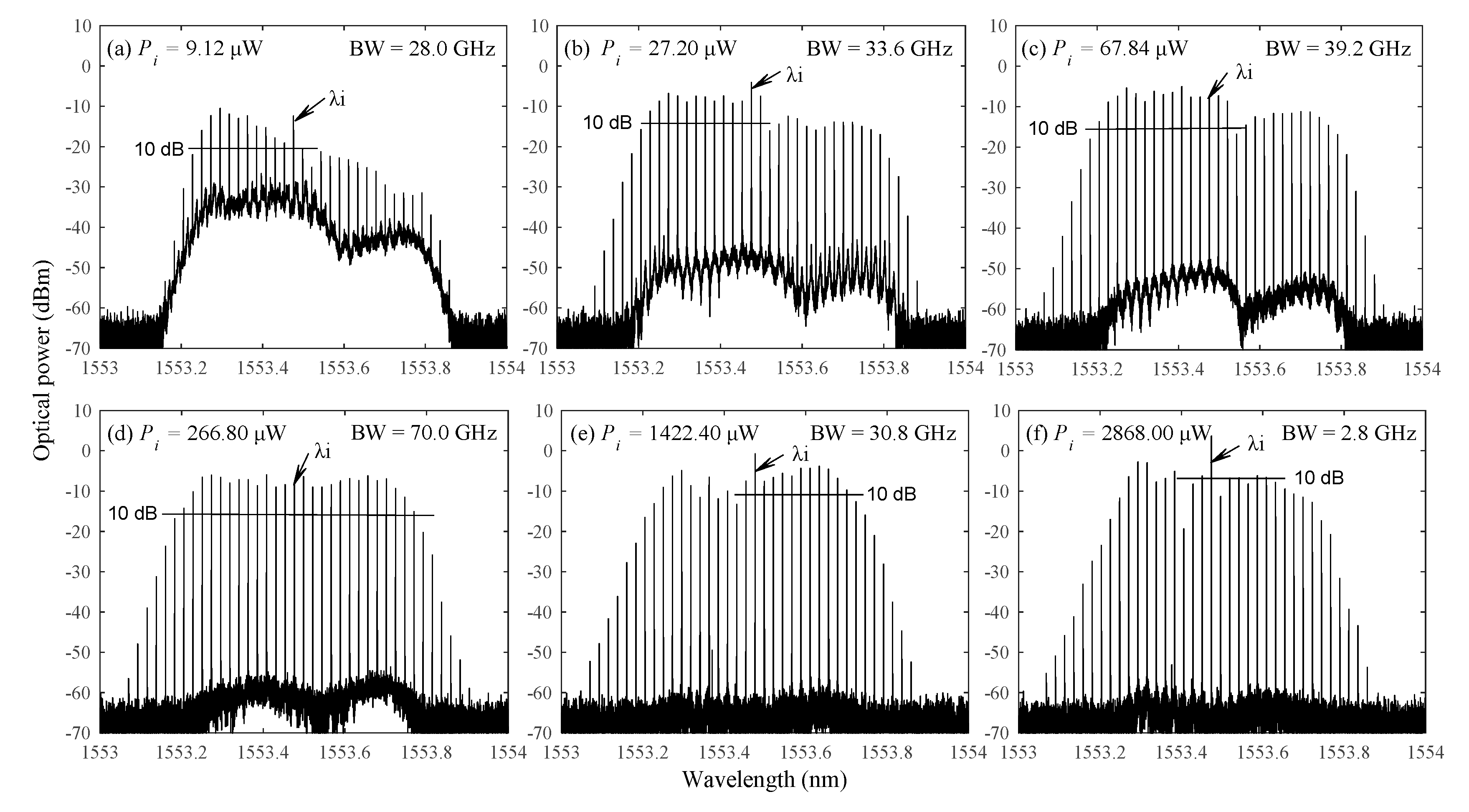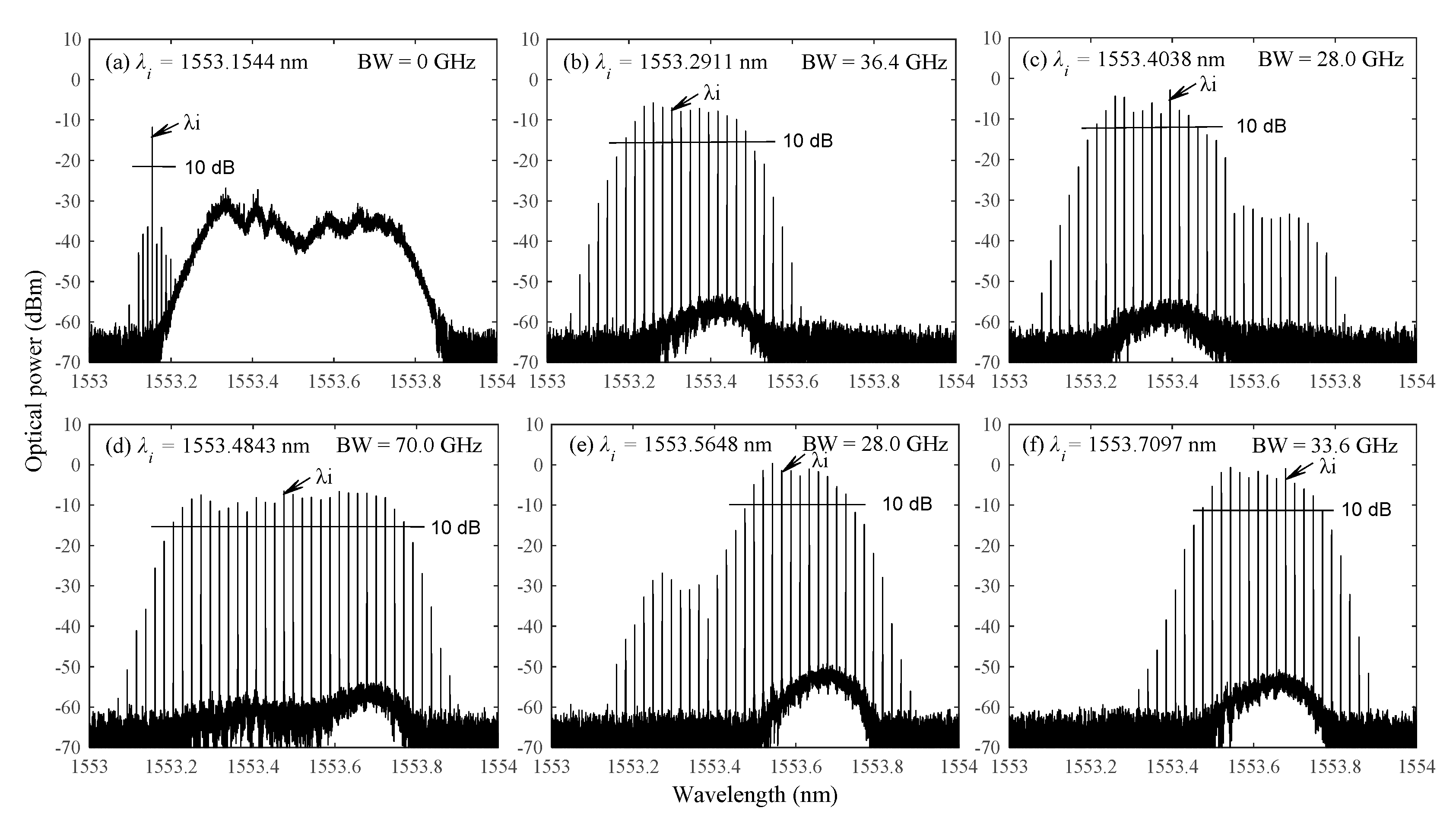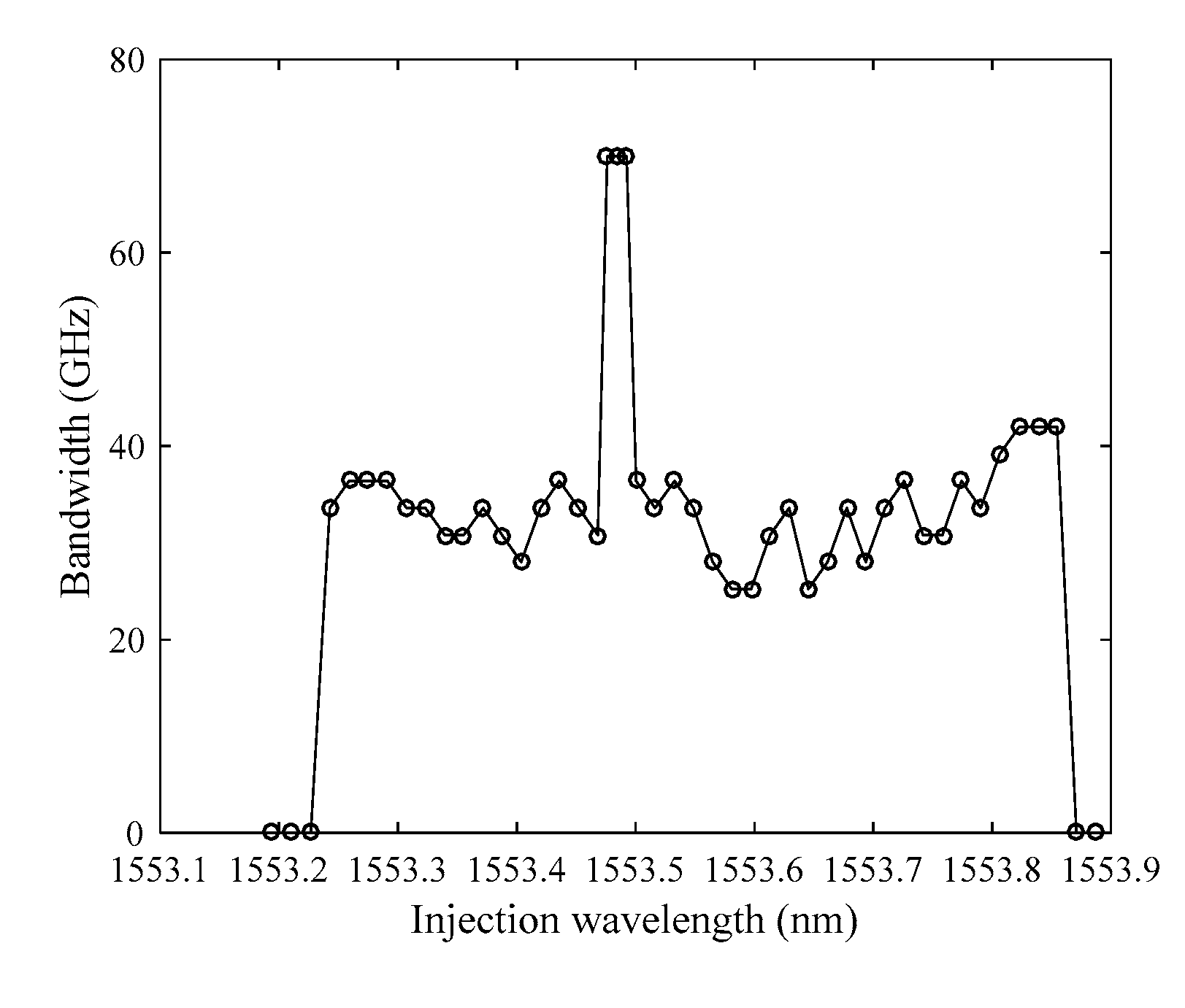Generation of Broadband Optical Frequency Comb Based on a Gain-Switching 1550 nm Vertical-Cavity Surface-Emitting Laser under Optical Injection
Abstract
:1. Introduction
2. Experimental Setup
3. Results and Discussion
4. Conclusions
Author Contributions
Funding
Conflicts of Interest
References
- Newbury, N.R. Searching for applications with a fine-tooth comb. Nat. Photon. 2011, 5, 186–188. [Google Scholar] [CrossRef]
- Diddams, S.; Vahala, K.; Udem, T. Optical frequency combs: Coherently uniting the electromagnetic spectrum. Science 2020, 369, 267–278. [Google Scholar]
- Yan, X.L.; Zou, X.H.; Pan, W.; Yan, L.S.; Azaña, J. Fully digital programmable optical frequency comb generation and application. Opt. Lett. 2018, 43, 283–286. [Google Scholar] [CrossRef] [PubMed]
- Cundiff, S.T.; Weiner, A.M.; Andrew, M. Optical arbitrary waveform generation. Nat. Photon. 2010, 4, 760–766. [Google Scholar] [CrossRef]
- Li, P.L.; Ma, X.L.; Shi, W.H.; Xu, E.M. Optical arbitrary waveform generation based on multi-wavelength semiconductor fiber ring laser. Opt. Laser Technol. 2017, 94, 228–233. [Google Scholar] [CrossRef]
- Zhou, X.; Zheng, X.P.; Wen, H.; Zhang, H.Y.; Guo, Y.L.; Zhou, B.K. All optical arbitrary waveform generation by optical frequency comb based on cascading intensity modulation. Opt. Commun. 2011, 284, 3706–3710. [Google Scholar] [CrossRef]
- Cingöz, A.; Yost, D.C.; Allison, T.K.; Ruehl, A.; Fermann, M.E.; Hartl, I.; Ye, J. Direct frequency comb spectroscopy in the extreme ultraviolet. Nature 2012, 482, 68–71. [Google Scholar] [CrossRef] [PubMed] [Green Version]
- Sadiek, I.; Mikkonen, T.; Vainio, M.; Toivonen, J.; Foltynowicz, A. Optical frequency comb photoacoustic spectroscopy. Phys. Chem. Chem. Phys. 2018, 20, 27849–27855. [Google Scholar] [CrossRef] [PubMed] [Green Version]
- He, J.; Long, F.T.; Deng, R.; Shi, J.; Dai, M.; Chen, L. Flexible multiband OFDM ultra-wideband services based on optical frequency combs. J. Opt. Commun. Netw. 2017, 9, 393–400. [Google Scholar] [CrossRef]
- Song, G.B.; Wang, T.S.; Dong, F.; Zhang, Y. Transmission characteristics of 24.5 Gb/s atmospheric laser communication based on optical frequency comb. Opt. Commun. 2020, 465, 125602. [Google Scholar] [CrossRef]
- Tan, J.; Zhao, Z.P.; Wang, Y.H.; Zhang, Z.K.; Liu, J.G.; Zhu, N.H. 12.5 Gb/s multi-channel broadcasting transmission for free-space optical communication based on the optical frequency comb module. Opt. Express 2018, 26, 2099–2106. [Google Scholar] [CrossRef] [PubMed]
- Hasanuzzaman, G.K.M.; Shams, H.; Renaud, C.C.; Mitchell, J.; Seeds, A.J.; Iezekiel, S. Tunable THz signal generation and radioover-fiber link based on an optoelectronic oscillator-driven optical frequency comb. J. Lightwave Technol. 2019, 38, 5240–5247. [Google Scholar] [CrossRef]
- Ponnampalam, L.; Fice, M.; Shams, H.; Renaud, C.; Seeds, A. Optical comb for generation of a continuously tunable coherent THz signal from 122.5 GHz to >2.7 THz. Opt. Lett. 2018, 43, 2507–2510. [Google Scholar] [CrossRef] [PubMed]
- Yu, J.G.; Li, K.L.; Chen, Y.X.; Zhao, L.; Huang, Y.T.; Li, Y.T.; Ma, J.; Shan, F.L. Terahertz-wave generation based on optical frequency comb and single mach-zehnder modulator. IEEE Photon. J. 2020, 12, 7900808. [Google Scholar] [CrossRef]
- Davila-Rodriguez, J.; Bagnell, K.; Delfyett, P.J. Frequency stability of a 10 GHz optical frequency comb from a semiconductor-based mode-locked laser with an intracavity 10,000 finesse etalon. Opt. Lett. 2013, 38, 3665–3668. [Google Scholar] [CrossRef]
- Parker, J.S.; Bhardwaj, A.; Binetti, P.R.A.; Yung-Jr, H.; Coldren, L.A. Monolithically integrated gain-flattened ring mode-locked laser for comb-line generation. IEEE Photon. Technol. Lett. 2012, 24, 131–133. [Google Scholar] [CrossRef]
- He, C.; Pan, S.L.; Guo, R.H.; Zhao, Y.J.; Pan, M.H. Ultraflat optical frequency comb generated based on cascaded polarization modulators. Opt. Lett. 2012, 37, 3834–3836. [Google Scholar] [CrossRef]
- Li, X.Y.; Xiao, J.N. Flattened optical frequency-locked multi-carrier generation by cascading one EML and one phase modulator driven by different RF clocks. Opt. Fiber Technol. 2015, 23, 116–121. [Google Scholar] [CrossRef]
- Li, D.; Wu, S.B.; Liu, Y.; Guo, Y.F. Flat optical frequency comb generation based on a dual-parallel Mach–Zehnder modulator and a single recirculation frequency shift loop. Appl. Opt. 2020, 59, 1916–1923. [Google Scholar] [CrossRef]
- Qu, K.; Zhao, S.H.; Li, X.; Tan, Q.G.; Zhu, Z.H. Ultraflat and broadband optical frequency comb generator based on cascaded two dual-electrode Mach–Zehnder modulators. Opt. Rev. 2018, 25, 264–270. [Google Scholar] [CrossRef]
- Wang, Z.F.; Ma, M.; Sun, H.; Khalil, M.; Adams, R.; Yim, K.; Jin, X.; Chen, L.R. Optical frequency comb generation using CMOS compatible cascaded Mach–Zehnder modulators. IEEE J. Quantum Electron. 2019, 55, 8400206. [Google Scholar] [CrossRef]
- Anandarajah, P.M.; Maher, R.; Xu, Y.Q.; Latkowski, S.; O’Carroll, J.; Murdoch, S.G.; Phelan, R.; O’Gorman, J.; Barry, L.P. Generation of coherent multicarrier signals by gain switching of discrete mode lasers. IEEE Photon. J. 2011, 3, 112–122. [Google Scholar] [CrossRef]
- Zhou, R.; Latkowski, S.; O’Carroll, J.; Phelan, R.; Barry, L.P.; Anandarajah, P. 40 nm wavelength tunable gain-switched optical comb source. Opt. Express 2011, 19, 415–420. [Google Scholar] [CrossRef] [PubMed]
- Gheorma, I.L.; Gopalakrishnan, G.K. Flat frequency comb generation with an integrated dual-parallel modulator. IEEE Photon. Technol. Lett. 2007, 19, 1011–1013. [Google Scholar] [CrossRef]
- Wu, R.; Supradeepa, V.R.; Long, C.M.; Leaird, D.E.; Weiner, A.M. Generation of very flat optical frequency combs from continuous-wave lasers using cascaded intensity and phase modulators driven by tailored radio frequency waveforms. Opt. Lett. 2010, 35, 3234–3236. [Google Scholar] [CrossRef]
- Rosado, A.; Pérez-Serrano, A.; Tijero, J.M.G.; Valle, Á.; Pesquera, L.; Esquivias, I. Experimental study of optical frequency comb generation in gain-switched semiconductor lasers. Opt. Laser Technol. 2018, 108, 542–550. [Google Scholar] [CrossRef]
- Pascual, M.D.G.; Zhou, R.; Smyth, F.; Anandarajah, P.M.; Barry, L.P. Software reconfigurable highly flexible gain switched optical frequency comb source. Opt. Express 2015, 23, 23225–23235. [Google Scholar] [CrossRef]
- Zhu, H.T.; Wang, R.; Pu, T.; Xiang, P.; Zheng, J.L.; Fang, T. A novel approach for generating flat optical frequency comb based on externally injected gain-switching distributed feedback semiconductor laser. Laser Phys. Lett. 2016, 14, 026201. [Google Scholar] [CrossRef]
- Anandarajah, P.M.; Duill, S.P.O.; Zhou, R.; Barry, L.P. Enhanced optical comb generation by gain-switching a single-mode semiconductor laser close to its relaxation oscillation frequency. IEEE J. Sel. Top. Quantum Electron. 2015, 21, 592–600. [Google Scholar] [CrossRef]
- Koyama, F. Recent advances of VCSEL photonics. J. Lightwave Technol. 2006, 24, 4502–4513. [Google Scholar] [CrossRef]
- Jewell, J.L.; Harbison, J.P.; Scherer, A.; Lee, Y.H.; Florez, L.T. Vertical-cavity surface-emitting lasers: Design, growth, fabrication, characterization. IEEE J. Quantum Electron. 1991, 27, 1332–1346. [Google Scholar] [CrossRef] [Green Version]
- Prior, E.; De Dios, C.; Ortsiefer, M.; Meissner, P.; Acedo, P. Understanding VCSEL-based gain switching optical frequency combs: Experimental study of polarization dynamics. J. Lightwave Technol. 2015, 33, 4572–4579. [Google Scholar] [CrossRef]
- Quirce, A.; De Dios, C.; Valle, A.; Pesquera, L.; Acedo, P. Polarization dynamics in VCSEL-based gain switching optical frequency combs. J. Lightwave Technol. 2018, 36, 1798–1806. [Google Scholar] [CrossRef]
- Prior, E.; De Dios, C.; Criado, R.; Ortsiefer, M.; Meissner, P.; Acedo, P. Dynamics of dual-polarization VCSEL-based optical frequency combs under optical injection locking. Opt. Lett. 2016, 41, 4083–4086. [Google Scholar] [CrossRef] [PubMed]
- Quirce, A.; De Dios, C.; Valle, A.; Acedo, P. VCSEL-based optical frequency combs expansion induced by polarized optical injection. IEEE J. Sel. Top. Quantum Electron. 2019, 25, 1500109. [Google Scholar] [CrossRef]
- Ma, L.H.; Xia, G.Q.; Chen, J.J.; Wu, Z.M. Temperature dependence of characteristic parameters of 1550 nm vertical-cavity surface-emitting laser. Acta Phys. Sin. 2018, 67, 214204. [Google Scholar]
- Perez, P.; Valle, A.; Noriega, I.; Pesquera, L. Measurement of the intrinsic parameters of single-mode VCSELs. J. Lightwave Technol. 2014, 32, 1601–1607. [Google Scholar] [CrossRef] [Green Version]
- Chen, J.J.; Wu, Z.M.; Deng, T.; Tang, X.; Yang, X.; Xia, G.Q. Current- and feedback-induced state bistability in a 1550 nm-VCSEL with negative optoelectronic feedback. IEEE Photon. J. 2017, 9, 1500310. [Google Scholar] [CrossRef]
- Deng, T.; Xia, G.Q.; Chen, J.J.; Tang, X.; Lin, X.D.; Yang, X.; Huang, S.W.; Wu, Z.M. Experimental investigation on nonlinear dynamics of 1550 nm VCSEL simultaneously subject to orthogonal optical injection and negative optoelectronic feedback. Laser Phys. 2017, 27, 045402. [Google Scholar] [CrossRef]
- Rosado, A.; Pérez, A.; Tijero, J.M.G.; Gutierrez, A.V.; Pesquera, L.; Esquivias, I. Numerical and experimental analysis of optical frequency comb generation in gain-switched semiconductor lasers. IEEE J. Quantum Electron. 2019, 55, 2001012. [Google Scholar] [CrossRef]









Publisher’s Note: MDPI stays neutral with regard to jurisdictional claims in published maps and institutional affiliations. |
© 2020 by the authors. Licensee MDPI, Basel, Switzerland. This article is an open access article distributed under the terms and conditions of the Creative Commons Attribution (CC BY) license (http://creativecommons.org/licenses/by/4.0/).
Share and Cite
Ren, H.; Fan, L.; Liu, N.; Wu, Z.; Xia, G. Generation of Broadband Optical Frequency Comb Based on a Gain-Switching 1550 nm Vertical-Cavity Surface-Emitting Laser under Optical Injection. Photonics 2020, 7, 95. https://doi.org/10.3390/photonics7040095
Ren H, Fan L, Liu N, Wu Z, Xia G. Generation of Broadband Optical Frequency Comb Based on a Gain-Switching 1550 nm Vertical-Cavity Surface-Emitting Laser under Optical Injection. Photonics. 2020; 7(4):95. https://doi.org/10.3390/photonics7040095
Chicago/Turabian StyleRen, Huiping, Li Fan, Na Liu, Zhengmao Wu, and Guangqiong Xia. 2020. "Generation of Broadband Optical Frequency Comb Based on a Gain-Switching 1550 nm Vertical-Cavity Surface-Emitting Laser under Optical Injection" Photonics 7, no. 4: 95. https://doi.org/10.3390/photonics7040095





